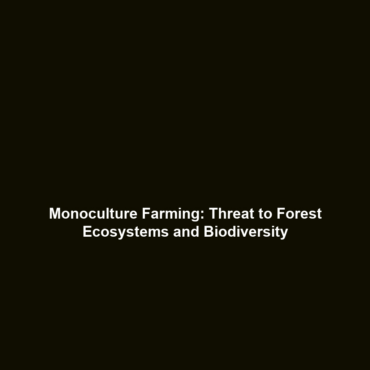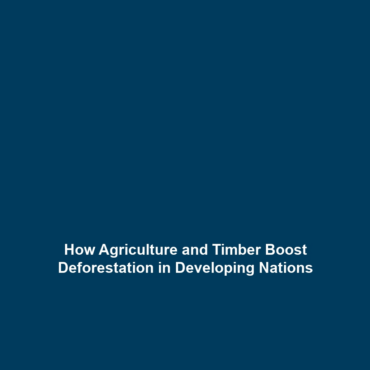The Impact of Monoculture Farming on Forest Ecosystems and Biodiversity
Introduction
Monoculture farming, the agricultural practice of growing a single crop over a large area, poses significant threats to forest ecosystems and biodiversity. This practice is a principal driver of deforestation and biodiversity loss, leading to a range of environmental challenges. Understanding the impact of monoculture farming is essential for developing sustainable agricultural practices that preserve our planet’s natural resources. As more forests are converted into agricultural land, the intricate relationships within these ecosystems are disrupted, resulting in long-term negative consequences for flora and fauna.
Key Concepts
The Definition of Monoculture Farming
Monoculture farming involves cultivating a single crop species, which contrasts with diverse farming systems. This practice is commonly used for cash crops like maize, soybeans, and palm oil. The simplicity of managing one crop can improve yield efficiency but often overlooks the potential environmental repercussions.
Environmental Impacts
The environmental impacts of monoculture farming include:
- Loss of habitat for wildlife, leading to decreased biodiversity.
- Soil degradation and nutrient depletion, requiring greater chemical inputs.
- Increased vulnerability to pests and diseases, resulting in higher pesticide use.
- Disruption of local water cycles and increased runoff, contributing to erosion.
Applications and Real-World Uses
The impact of monoculture farming can be observed in several significant real-world applications, particularly concerning deforestation and biodiversity loss. For instance:
- Cash Crop Production: In countries like Brazil and Indonesia, extensive areas of tropical forests have been cleared for monoculture plantations producing soy and palm oil, which affects local ecosystems.
- Agroforestry Practices: Some innovative farmers are integrating trees with crops to foster biodiversity while still benefiting from monocultural yields.
Current Challenges
The study and application of the impacts of monoculture farming on forest ecosystems face several challenges, including:
- Limited data on long-term ecological changes due to monoculture practices.
- Resistance from farmers who benefit financially from monoculture systems.
- The need for more comprehensive regulations to manage land-use practices effectively.
Future Research and Innovations
Research on monoculture farming’s impact on forest ecosystems is evolving, with several promising areas emerging:
- Biotechnology: Advances in genetic engineering may help cultivate higher-yield crops that require fewer inputs, minimizing ecological disruption.
- Agroecological Approaches: Innovative farming techniques that combine polyculture with traditional monoculture methods show potential for balancing productivity with biodiversity conservation.
Conclusion
In conclusion, the impact of monoculture farming on forest ecosystems and biodiversity is profound and far-reaching, significantly contributing to deforestation and biodiversity loss. As we face the urgent need to protect our natural resources, it becomes imperative to adopt sustainable agricultural practices. By understanding these impacts and their implications, we can move towards solutions that balance human needs with environmental stewardship. For further information on biodiversity conservation and sustainable agriculture, visit our related articles page.

